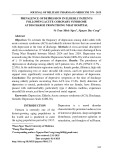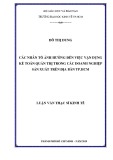
THAI BINH JOURNAL OF MEDICAL AND PHARMACY, VOLUME 16, ISSUE 2 - MARCH 2025
15
HbA1c CONTROL AND ASSOCIATED FACTORS AMONG TYPE 2 DIABETES
PATIENTS IN THAI BINH
Vũ Quang Hưng1, Dương Thị Ngọc Yến1,Đào Đinh Quốc1, Bùi Thị Trang1,
PhạmThái Phương1, Trần Thị Thuỳ Dương1, Bùi Thị Minh Phượng1*
1.Thai Binh University of Medicine and Pharmacy
*Corresponding author: Bui Thi Minh Phuong
Email: phuongbtm@tbump.edu.vn
Received date: 29/01/2025
Revised date: 15/02/2025
Accepted date: 30/02/2025
ABSTRACT
Objective: This study was conducted to investigate
HbA1c control and associated factors among type 2
diabetes patients in Thai Binh in 2024, to evaluate
the rate of achieving the HbA1c control target, and
to identify factors related to this control.
Method: The study included 371 type 2 diabetes
patients in Thai Binh. Demographic information,
underlying diseases, lifestyle habits, diet, and
treatment methods were collected and analyzed.
HbA1c levels and fasting blood glucose results
were recorded. Factors related to HbA1c control
were analyzed using statistical methods.
Results: The percentage of patients achieving the
HbA1c control target (< 6.5%) was 19.9%. Factors
such as disease duration, diet, smoking, and
complications had a significant impact on HbA1c
control. Patients with longer disease duration and
complications were at higher risk of not achieving
the HbA1c target.
Conclusion: Adhering to an appropriate diet
and treatment regimen can help improve the rate
of HbA1c control. Intervention strategies should
focus on raising awareness and improving patients’
lifestyle habits.
Keywords: Type 2 diabetes, HbA1c, glucose
control, Thai Binh, influencing factors, diet.
I. INTRODUCTION
Type 2 diabetes (T2D) is a chronic metabolic
disorder characterized by hyperglycemia resulting
from a combination of insulin resistance and reduced
insulin secretion. According to the International
Diabetes Federation (IDF), an estimated 463
million adults worldwide were living with diabetes
in 2019, and this number is expected to rise to 700
million by 2045 [1].
In Vietnam, type 2 diabetes has become a
significant public health issue. According to the
DiabCare Asia study in 2015, the percentage
of patients with type 2 diabetes in Vietnam who
achieved the HbA1c control target (<7%) was only
36.1%, with an average HbA1c value of 7.9% [2].
HbA1c control is a crucial factor in managing
diabetes, helping to reduce the risk of developing
chronic complications such as cardiovascular
disease, kidney failure, and nerve damage.
However, the rate of patients achieving the HbA1c
control target remains low, indicating the need
for more effective interventions in managing and
treating type 2 diabetes.
The study “Current Status of HbA1c Control in
Type 2 Diabetes Patients in Thai Binh in 2024”
aims to evaluate the rate of HbA1c control and
the factors associated with this control in type 2
diabetes patients in Thai Binh. The study’s findings
will provide important information to improve the
quality of treatment and management of type 2
diabetes in the local area.
II. SUBJECTS AND METHODS
2.1. Study Subjects
Inclusion criteria:
The study subjects are patients diagnosed with type
2 diabetes who are receiving treatment at medical
facilities in Thai Binh in 2024. The patients participating
in the study must meet the following criteria:
Diagnosed with type 2 diabetes according to the
World Health Organization (WHO) criteria.
Aged 18 years or older.
Willing to participate in the study and sign an
informed consent form.
Exclusion criteria:
Patients with the following characteristics will be
excluded from the study:
Type 1 diabetes or secondary diabetes.
Acute or unstable diseases (such as severe
infections, acute cardiovascular diseases, acute
liver or kidney diseases).
Patients who are unable to participate or refuse
to participate in the study.
2.2. Research Methodology
2.2.1. Study Design:

























